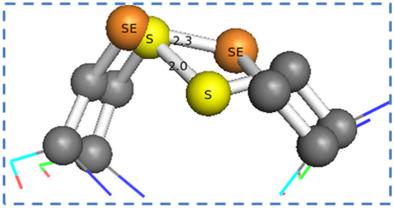当前位置:
X-MOL 学术
›
J. Pept. Sci.
›
论文详情
Our official English website, www.x-mol.net, welcomes your
feedback! (Note: you will need to create a separate account there.)
Characterization of (Boc-Cys/Sec-NHMe)2 and (Boc-Cys/Sec-OMe)2 : Evidence of local conformational difference between disulfide and diselenide.
Journal of Peptide Science ( IF 1.8 ) Pub Date : 2020-02-26 , DOI: 10.1002/psc.3245 Ashwini Dolle 1 , K Kasi Amarnath Reddy 1 , Shubha Shridhar Gunaga 2 , Kiran Krishnamurthy 3 , Dillip Kumar Senapati 3 , Abhijit Rana 4 , Kishorkumar Sindogi 2 , Himansu S Biswal 4 , Srinivasarao Raghothama 3 , Konkallu Hanumae Gowd 1
Journal of Peptide Science ( IF 1.8 ) Pub Date : 2020-02-26 , DOI: 10.1002/psc.3245 Ashwini Dolle 1 , K Kasi Amarnath Reddy 1 , Shubha Shridhar Gunaga 2 , Kiran Krishnamurthy 3 , Dillip Kumar Senapati 3 , Abhijit Rana 4 , Kishorkumar Sindogi 2 , Himansu S Biswal 4 , Srinivasarao Raghothama 3 , Konkallu Hanumae Gowd 1
Affiliation

|
Conformations of disulfide and diselenide were compared in (Boc‐Cys/Sec‐NHMe)2 and (Boc‐Cys/Sec‐OMe)2 using X‐ray crystallography, nuclear magnetic resonance (NMR) spectroscopy, density functional theory (DFT), and circular dichroism (CD) spectroscopy. Conformations of disulfide/diselenide in polypeptides are defined based on the sign of side chain torsion angle χ3 (–CH2–S/Se–S/Se–CH2–); negative indicates left‐handed and positive indicates right‐handed orientation. In the crystals of (Boc‐Cys‐OMe)2 and (Boc‐Sec‐OMe)2, the disulfide exhibits a left‐handed and the diselenide a right‐handed orientation. Characterization of cystine and selenocystine derivatives in solution using 1H‐NMR, natural abundant 77Se NMR, 2D‐ROESY, and chemical shift analysis coupled to DMSO titration has indicated the symmetrical nature and antiparallel orientation of Cys/Sec residues about the disulfide/diselenide bridges. Structural calculations of cystine and selenocystine derivatives using DFT further support the antiparallel orientation of Cys/Sec residues about disulfide/diselenide. The far‐ultraviolet (UV) region CD spectra of cystine and selenocystine derivatives have exhibited the negative Cotton effect (CE) for disulfide and positive for diselenide confirming the difference in the conformational preference of disulfide and diselenide. In the previously reported polymorphic structure of (Boc‐Sec‐OMe)2, the diselenide has right‐handed orientation. In the X‐ray structures of disulfide and diselenide analogues of Escherichia coli protein encoded by curli specific gene C (CgsC) retrieved from Protein Databank (PDB), disulfide has left‐handed and the diselenide right‐handed orientation. The current report provides the evidence for the local conformational difference between a disulfide and a diselenide group under unconstrained conditions, which may be useful for the rational replacement of disulfide by diselenide in polypeptide chains.
中文翻译:

(Boc-Cys / Sec-NHMe)2和(Boc-Cys / Sec-OMe)2的表征:二硫化物和二硒化物之间局部构象差异的证据。
使用X射线晶体学,核磁共振(NMR)光谱,密度泛函理论(DFT)对(Boc-Cys / Sec-NHMe)2和(Boc-Cys / Sec-OMe)2中的二硫化物和二硒化物的构型进行了比较,和圆二色性(CD)光谱。在多肽二硫化物/二硒化物的构象是基于侧链扭转角χ符号确定3(-CH 2 -S / SE-S / SE-CH 2 - ); 负表示左手,而正表示右手。在(Boc-Cys-OMe)2和(Boc-Sec-OMe)2的晶体中,二硫化物呈左旋,二硒化物呈右旋。使用1 H-NMR表征溶液中的胱氨酸和硒代半胱氨酸衍生物,天然丰富77Se NMR,2D-ROESY和化学位移分析结合DMSO滴定表明Cys / Sec残基在二硫键/二硒键上的对称性质和反平行方向。使用DFT对胱氨酸和硒代胱氨酸衍生物的结构计算进一步支持了Cys / Sec残基围绕二硫键/二硒键的反平行方向。胱氨酸和硒代半胱氨酸衍生物的远紫外(CD)光谱对二硫化物表现出负棉花效应(CE),对二硒化物表现出正棉花效应,证实了二硫化物和二硒化物的构象偏好不同。在先前报道的(Boc-Sec-OMe)2多态结构中,二硒化物具有右旋取向。在X射线结构中,二硫化物和二硒化物类似物从蛋白质数据库(PDB)中检索到的卷曲蛋白特异基因C(CgsC)编码的大肠杆菌蛋白,左旋为二硫键,右旋为二硒化物。本报告提供了在不受限制的条件下二硫键和二硒键基团之间局部构象差异的证据,这可能对多肽链中的二硒键合理替代二硫键有用。
更新日期:2020-02-26
中文翻译:

(Boc-Cys / Sec-NHMe)2和(Boc-Cys / Sec-OMe)2的表征:二硫化物和二硒化物之间局部构象差异的证据。
使用X射线晶体学,核磁共振(NMR)光谱,密度泛函理论(DFT)对(Boc-Cys / Sec-NHMe)2和(Boc-Cys / Sec-OMe)2中的二硫化物和二硒化物的构型进行了比较,和圆二色性(CD)光谱。在多肽二硫化物/二硒化物的构象是基于侧链扭转角χ符号确定3(-CH 2 -S / SE-S / SE-CH 2 - ); 负表示左手,而正表示右手。在(Boc-Cys-OMe)2和(Boc-Sec-OMe)2的晶体中,二硫化物呈左旋,二硒化物呈右旋。使用1 H-NMR表征溶液中的胱氨酸和硒代半胱氨酸衍生物,天然丰富77Se NMR,2D-ROESY和化学位移分析结合DMSO滴定表明Cys / Sec残基在二硫键/二硒键上的对称性质和反平行方向。使用DFT对胱氨酸和硒代胱氨酸衍生物的结构计算进一步支持了Cys / Sec残基围绕二硫键/二硒键的反平行方向。胱氨酸和硒代半胱氨酸衍生物的远紫外(CD)光谱对二硫化物表现出负棉花效应(CE),对二硒化物表现出正棉花效应,证实了二硫化物和二硒化物的构象偏好不同。在先前报道的(Boc-Sec-OMe)2多态结构中,二硒化物具有右旋取向。在X射线结构中,二硫化物和二硒化物类似物从蛋白质数据库(PDB)中检索到的卷曲蛋白特异基因C(CgsC)编码的大肠杆菌蛋白,左旋为二硫键,右旋为二硒化物。本报告提供了在不受限制的条件下二硫键和二硒键基团之间局部构象差异的证据,这可能对多肽链中的二硒键合理替代二硫键有用。










































 京公网安备 11010802027423号
京公网安备 11010802027423号